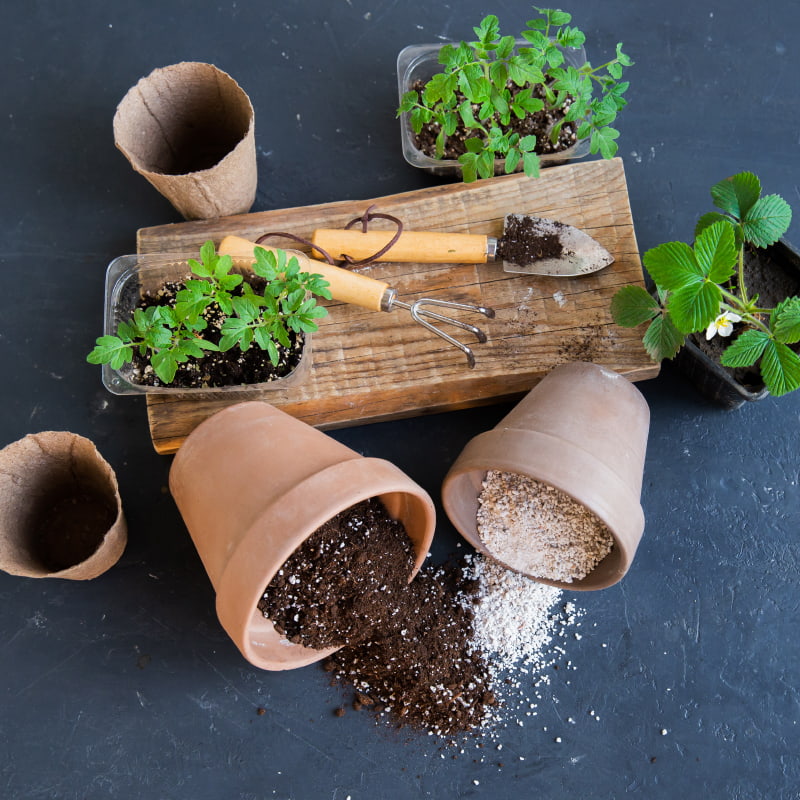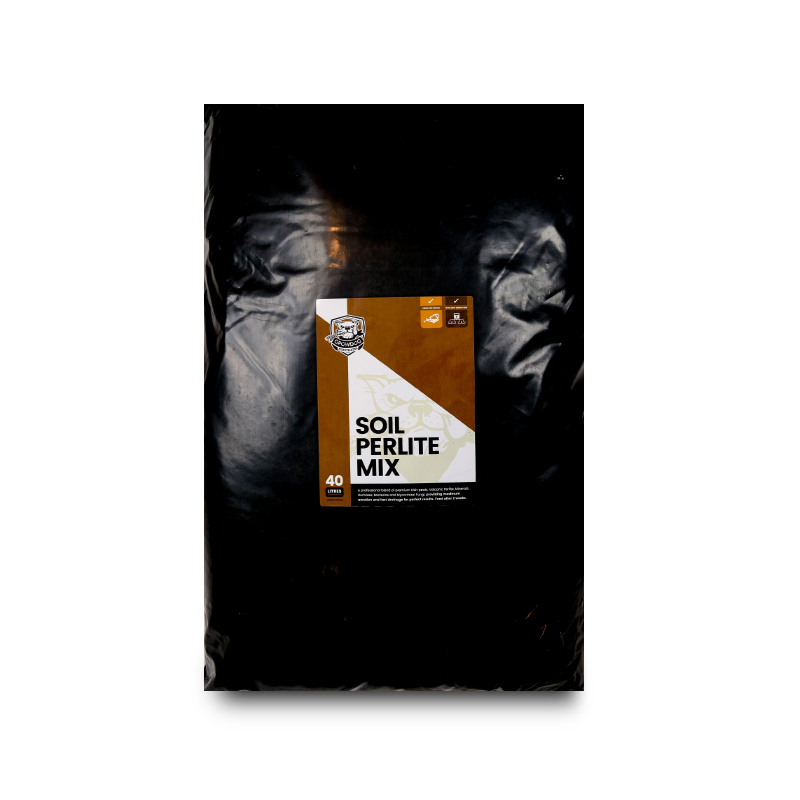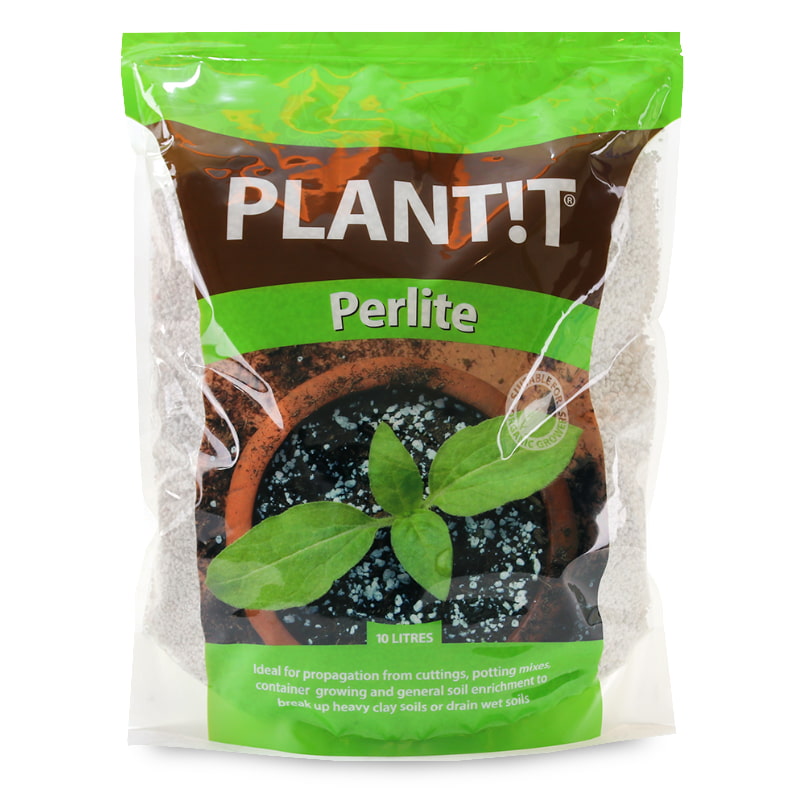Using Perlite
What is Perlite & How Is It Used?
Using Perlite is great option for a variety of applications to grow superb flowers, vegetables and fruit. Perlite is a highly porous material that is incredibly absorbent. It is recognisable to most as small, porous, crumbly, white grains. Perlite is a mined volcanic rock product, made from a type of volcanic glass that has been superheated until it expands.
It can be used as a media additive to increase water retention and as a growing media in its own right to propagate cuttings or even grow seeds. You can even grow hydroponic plants in a bucket system using nothing but perlite.
Perlite retains water and nutrients in its porous structure, but it never becomes soggy. It maintains its structure and air pockets ensure that plenty of oxygen get to the root zone of the plant. As long as water can flow out of the planting container, perlite ensures good drainage, so it is ideal for use in flood & drain systems. As with other inorganic substrates, perlite is inert and sterile. It also insulates well against temperature changes.
Benefits Of Perlite
Versatile
Perlite can be used as a sole growing medium for many types of plant. Alternatively it can be used in a mixed ratio. Either in a 50/50 mix with Vermiculite (similar to Perlite), which is often used for starting seeds off. Alternatively you can buy it in a coco or soil mix where the Perlite ratio is around 20-30% and assists the dominant medium with drainage, aeration and over all structure.
Great Water Retention, Drainage & Aeration
Thanks to its porosity, Perlite has a capacity for water retention, up to 5 times its weight. Perlite is also a natural filtration system, allowing excess water to easily drain away while retaining a little moisture and catching nutrients that plants need to grow.
Airflow in the soil or Coco is greatly improved when Perlite is added, which is necessary for your plant’s roots to breathe and for any beneficial organisms that may be living within. Because Perlite is a mineral glass and thus harder than the soil around it, it also helps to slow down compaction, which keeps your soil fluffy and lightweight.
Reusable
Perlite is reusable. The only time you might throw perlite away is if you have any disease issues whilst using it and have no good way to sterilise it. If you have encountered something like Pythium, then you’ll definitely want to wipe out the spores which are the infecting part of the disease before you use that media with new crops. You can sterilise the media by using a hydrogen peroxide solution or bleach solution, but you must rinse thoroughly afterwards.
It’s worth mentioning here that perlite is a non-renewable resource which may impact on the decision-making process for some growers. However, there is currently a vast global supply of perlite in existence and so far in 60 years we have only used 1% of that natural supply!
pH Neutral
Perlite has a neutral pH, which allows for better control over the fertiliser and the nutrient solution given to your plants. There is no rinsing or buffering required to “correct” the pH. Simply adjust the solution and water it in. Perlite will take on the acidity or alkalinity of the liquids that saturate it. Even when rinsed and dried, the naturally occurring pH of 7.0 isn’t going to harm a typical indoor garden. A neutral media can be much more convenient and better for long-term system health.
Compatible with Standard Nutrients
Most standard hydroponic mineral/ionic nutrients will be compatible when using Perlite as a sole medium. These are the most widely available and reasonably priced nutrient ranges and so you shouldn’t incur any added expense.
Pest Resistant
Stable and inert, perlite does not attract any insects, unlike some soil or coco based potting mixes. Because perlite is inorganic, and given the extreme heat used to create it, there is very little chance for bacterial, fungal, or insect infestations. Therefore, unlike some other soilless media, it requires no sterilisation before its initial use.
7 Top Tips For Using Perlite
1. Soil and Coco Perlite Mixes
Perlite is a great medium to mix in with soil (80/20). The perlite provides structure to the substrate to prevents compaction. Perlite acts to hold water, nutrients and air pockets so you can go longer in between watering and plants can still have access to what they need.

2. Check What You Buy
Although not classed as a synthetic material, perlite can have a detrimental effect on the local ecological environment because it is strip mined. So before you buy, it is worth looking at how each company mine their perlite, how they maintain soil composition and ecology, and what they do to restore the environment. Responsible mining should not leave the landscape damaged.
3. Choose The Right Type Of Perlite
Should you be using coarse perlite as opposed to medium or fine grade? If you are buying a pre-made Perlite/soil potting mix then the decision will have been made for you but if you are looking at buying or using Perlite on its own then this is an important question that you need to consider.

Coarse perlite has the highest air porosity, so it offers the most drainage and aeration for your roots. This is the most popular among those who grow Indoors in pots as it provides excellent drainage. The finer stuff is better suited for use in quality seed-starting mixes or rooting cuttings as the drainage provided encourages rapid root production.
4. Rinse Prior To Use
Perlite is non-fibrous, which makes it safe for use however the dust that is produced from it can be harmful if it gets into your lungs. It is best therefore to work with it when it is moist to prevent the inhalation of these dust particles. The best thing to do prior to use is to give your perlite a good rinse with clean water in order to remove as much of the dust and debris as possible.
5. Use Alongside But Do Not Substitute With Vermiculite
Contrary to what some people will tell you, Perlite and Vermiculite are not the same thing. Perlite is free draining, and Vermiculite hangs on to a lot of water. They can be used together and a popular option is using Perlite in a 50/50 Vermiculite mix. This is ideal for most young plants and gives you the best of both mediums. The problems come if you try and substitute one for the other in a variety of situations.
Both products are very lightweight and increase aeration in your potting mix, however Vermiculite is close to a neutral pH whereas perlite has a slightly more alkaline pH. The fact that vermiculite holds moisture longer than perlite makes their usage different. When plants need more water-retentive soil or for seed-starting, you should use vermiculite. For plants that prefer quick-drying soil or for starting cuttings you should use perlite.
6. Check System Suitability Before Using
Perlite, is lightweight, which makes it problematic for hydroponic grow systems where it might float. DWC (Deep Water Culture) is an obvious one. With ebb and flow, the perlite particles may slowly travel towards the surface of grow pots, causing uneven distribution within the pot. Any grow system where flooding is a part of normal operations may not be appropriate for using perlite. It is good for use with any soil or coco based medium as it will successfully provide aeration and drainage.
7. Using Perlite to Protect the Surface Of Your Medium
Mould and moss can grow on the medium’s surface if it remains wet most of the time.
Perlite helps resolve these issues when used in the proper ratio. When placed on the surface of the grow media it will wick away moisture from the surface and reduce or eliminate mould and moss.





